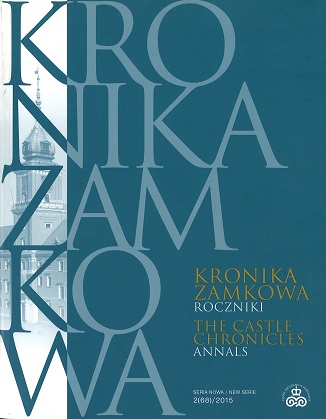Dwór królewski w Rzeczypospolitej polsko-litewskiej w epoce panowania Wettinów: opinie polskiej historiografii
The Royal Court of the Polish-Lithuanian Commonwealth during the reign of the Wettins in Polish historiography
Author(s): Adam PerłakowskiSubject(s): Fine Arts / Performing Arts, History of Art
Published by: Arx Regia® Wydawnictwo Zamku Królewskiego w Warszawie – Muzeum
Keywords: House of Wettin; royal court; Polish historiography; Polish-Lithuanian Commonwealth
Summary/Abstract: The aim of this article is to summarize the current state of research and information in Polish historiography regarding the court of August II the Strong and August III of the House of Wettin, starting with the findings of nineteenth-century historians (Kazimierz Jarochowski), and ending with the latest publications concerning the court’s cultural and artistic activities. Although our knowledge of the rule of the Saxon dynasty has increased over the past few years, there is still no standard synthesis of the history of the royal court in the Polish-Lithuanian Commonwealth in the first half of the eighteenth century. These publications, which were written before the Second World War are unable to refute the criticism levied at them about the methodology used, and the manner of interpretation of court events. The court—and the Wettin court in particular—was a very complex institution, not only because of the variety of its functions, but also because it was functioning in a state which was in personal union with another, interconnected only by the persona of the king. Saxon and Polish influences converged at court and because young Poles recognized in this an opportunity to build their careers, they hedged their bets with the court circles of both kings. The vast number of surviving sources about the court of the Wettins also determines the direction of research. At present, it would appear that it is not possible to study and analyse the entire structure and the activities of the royal court of that time. And although there has been quite a lot of research carried out on the question of the influence of the king and his entourage on culture and art in their broadest sense (music, theatre, opera, ballet, painting, architecture and building work) and even on customs, relatively little is still known about how the Polish political elite perceived the Saxon court. The first, recently published, articles addressing this issue clearly indicate how much tential scope there is for further research. The results of studies on the Wettin court in the PolishLithuanian Commonwealth should be published together with critical editions of the sources showing the institution of the royal court about which little is still known
Journal: Kronika Zamkowa. Roczniki
- Issue Year: 2/2015
- Issue No: 2
- Page Range: 165-201
- Page Count: 37
- Language: Polish

